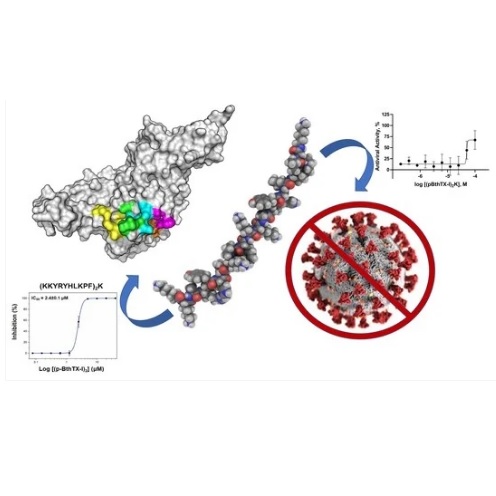Non-Toxic dimeric peptides derived from the bothropstoxin-I are potent SARS-CoV-2 and papain-like protease inhibitors.
FREIRE, Marjorie Caroline Liberato Cavalcanti; NOSKE, Gabriela Dias; BITENCOURT, Natália V.; SANCHES, Paulo R. S.; SANTOS-FILHO, Norival A.; OLIVEIRA, Victor Gawriljuk Ferraro; SOUZA, Eduardo Pereira de; NOGUEIRA, Victor Henrique Rabesquine; GODOY, Mariana Ortiz de; NAKAMURA, Aline Minali; FERNANDES, Rafaela Sachetto; GODOY, Andre Schutzer de; JULIANO, Maria A.; PERES, Bianca de Miranda; BARBOSA, Cecília G.; MORAES, Carolina B.; FREITAS JUNIOR, Lucio Holanda Gondim de; CILLI, Eduardo Maffud; GUIDO, Rafael Victorio Carvalho; OLIVA, Glaucius.
FREIRE, Marjorie Caroline Liberato Cavalcanti; NOSKE, Gabriela Dias; BITENCOURT, Natália V.; SANCHES, Paulo R. S.; SANTOS-FILHO, Norival A.; OLIVEIRA, Victor Gawriljuk Ferraro; SOUZA, Eduardo Pereira de; NOGUEIRA, Victor Henrique Rabesquine; GODOY, Mariana Ortiz de; NAKAMURA, Aline Minali; FERNANDES, Rafaela Sachetto; GODOY, Andre Schutzer de; JULIANO, Maria A.; PERES, Bianca de Miranda; BARBOSA, Cecília G.; MORAES, Carolina B.; FREITAS JUNIOR, Lucio Holanda Gondim de; CILLI, Eduardo Maffud; GUIDO, Rafael Victorio Carvalho; OLIVA, Glaucius.




 Abstract: The COVID-19 outbreak has rapidly spread on a global scale, affecting the economy and public health systems throughout the world. In recent years, peptide-based therapeutics have been widely studied and developed to treat infectious diseases, including viral infections. Herein, the antiviral effects of the lysine linked dimer des-Cys11, Lys12,Lys13-(pBthTX-I)2K ((pBthTX-I)2K)) and derivatives against SARS-CoV-2 are reported. The lead peptide (pBthTX-I)2K and derivatives showed attractive inhibitory activities against SARS-CoV-2 (EC50 = 28?65 µM) and mostly low cytotoxic effect (CC50 > 100 µM). To shed light on the mechanism of action underlying the peptides? antiviral activity, the Main Protease (Mpro) and Papain-Like protease (PLpro) inhibitory activities of the peptides were assessed. The synthetic peptides showed PLpro inhibition potencies (IC50s = 1.0?3.5 µM) and binding affinities (Kd = 0.9?7 µM) at the low micromolar range but poor inhibitory activity against Mpro (IC50 > 10 µM). The modeled binding mode of a representative peptide of the series indicated that the compound blocked the entry of the PLpro substrate toward the protease catalytic cleft. Our findings indicated that non-toxic dimeric peptides derived from the Bothropstoxin-I have attractive cellular and enzymatic inhibitory activities, thereby suggesting that they are promising prototypes for the discovery and development of new drugs against SARS-CoV-2 infection.
Abstract: The COVID-19 outbreak has rapidly spread on a global scale, affecting the economy and public health systems throughout the world. In recent years, peptide-based therapeutics have been widely studied and developed to treat infectious diseases, including viral infections. Herein, the antiviral effects of the lysine linked dimer des-Cys11, Lys12,Lys13-(pBthTX-I)2K ((pBthTX-I)2K)) and derivatives against SARS-CoV-2 are reported. The lead peptide (pBthTX-I)2K and derivatives showed attractive inhibitory activities against SARS-CoV-2 (EC50 = 28?65 µM) and mostly low cytotoxic effect (CC50 > 100 µM). To shed light on the mechanism of action underlying the peptides? antiviral activity, the Main Protease (Mpro) and Papain-Like protease (PLpro) inhibitory activities of the peptides were assessed. The synthetic peptides showed PLpro inhibition potencies (IC50s = 1.0?3.5 µM) and binding affinities (Kd = 0.9?7 µM) at the low micromolar range but poor inhibitory activity against Mpro (IC50 > 10 µM). The modeled binding mode of a representative peptide of the series indicated that the compound blocked the entry of the PLpro substrate toward the protease catalytic cleft. Our findings indicated that non-toxic dimeric peptides derived from the Bothropstoxin-I have attractive cellular and enzymatic inhibitory activities, thereby suggesting that they are promising prototypes for the discovery and development of new drugs against SARS-CoV-2 infection. @article={003038894,author = {FREIRE, Marjorie Caroline Liberato Cavalcanti; NOSKE, Gabriela Dias; BITENCOURT, Natália V.; SANCHES, Paulo R. S.; SANTOS-FILHO, Norival A.; OLIVEIRA, Victor Gawriljuk Ferraro; SOUZA, Eduardo Pereira de; NOGUEIRA, Victor Henrique Rabesquine; GODOY, Mariana Ortiz de; NAKAMURA, Aline Minali; FERNANDES, Rafaela Sachetto; GODOY, Andre Schutzer de; JULIANO, Maria A.; PERES, Bianca de Miranda; BARBOSA, Cecília G.; MORAES, Carolina B.; FREITAS JUNIOR, Lucio Holanda Gondim de; CILLI, Eduardo Maffud; GUIDO, Rafael Victorio Carvalho; OLIVA, Glaucius.},title={Non-Toxic dimeric peptides derived from the bothropstoxin-I are potent SARS-CoV-2 and papain-like protease inhibitors},journal={Molecules},note={v. 26, n. 16, p. 4896-1-4896-17},year={2021}}
@article={003038894,author = {FREIRE, Marjorie Caroline Liberato Cavalcanti; NOSKE, Gabriela Dias; BITENCOURT, Natália V.; SANCHES, Paulo R. S.; SANTOS-FILHO, Norival A.; OLIVEIRA, Victor Gawriljuk Ferraro; SOUZA, Eduardo Pereira de; NOGUEIRA, Victor Henrique Rabesquine; GODOY, Mariana Ortiz de; NAKAMURA, Aline Minali; FERNANDES, Rafaela Sachetto; GODOY, Andre Schutzer de; JULIANO, Maria A.; PERES, Bianca de Miranda; BARBOSA, Cecília G.; MORAES, Carolina B.; FREITAS JUNIOR, Lucio Holanda Gondim de; CILLI, Eduardo Maffud; GUIDO, Rafael Victorio Carvalho; OLIVA, Glaucius.},title={Non-Toxic dimeric peptides derived from the bothropstoxin-I are potent SARS-CoV-2 and papain-like protease inhibitors},journal={Molecules},note={v. 26, n. 16, p. 4896-1-4896-17},year={2021}}